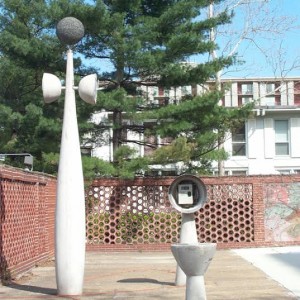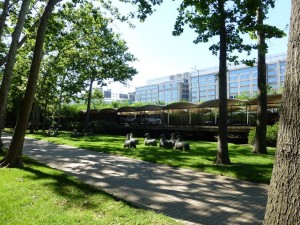
On July 10th, the DC Historic Preservation Review Board voted to designate Capitol Park Tower (301 G Street SW) as an historic landmark. The application was submitted by the Southwest Neighborhood Assembly (SWNA) on behalf of the tenants of Capitol Park Tower, and prepared by SWNA History Task Force volunteers Cecille Chen and Madeline Clites. As an historic landmark, Capitol Park Tower takes its place in the District of Columbia Inventory of Historic Sites, alongside Tiber Island, Harbour Square, Town Center East, Arena Stage, and other historic landmarks in Southwest.
The landmark hearing was a contentious one that took almost three hours to resolve. The odds were stacked against the nomination because the historic preservation staff report opposed designation based on grounds that the entire complex of Capitol Park was more significant than the sum of its parts, and therefore more significant than Capitol Park Tower. The owner of the property also opposed the nomination and was represented by an attorney, an architectural historian, and a landscape architect who mounted a vigorous argument against Capitol Park Tower’s qualifications for historic significance. These arguments were countered by ANC6D commissioner David Garber, SWNA president Kael Anderson, and eight Southwest residents who testified in favor of the landmark nomination, including some Capitol Park Tower tenants who had lived in the building for decades. Moreover, the nomination was supported by nearly 50 Southwest residents and homeowners’ associations who had signed a letter urging the board to approve the landmark nomination. Additionally, the nomination was endorsed by Councilmember Tommy Wells, architectural historian Richard Longstreth, Southwest DC architect Eric Jenkins, and prominent preservation organizations including the DC Preservation League, the Cultural Landscape Foundation, and DoCoMoMo DC. After much discussion, the board voted four to one to designate the property as an historic landmark, acknowledging the masterful work of architect Chloethiel Woodard Smith and landscape architect Daniel Urban Kiley. Notably, Smith and Kiley had also collaborated on the award-winning Harbour Square, which was designated an historic landmark in 2013.
Capitol Park Tower was completed in 1962. It was the second of five high-rise buildings to be constructed in Capitol Park, a 30-acre complex that also features over 300 townhomes. Capitol Park Tower was designed in the modernist style promoted by Swiss architect Le Corbusier. The nine-story apartment building with a rectangular footprint is raised on massive piers, or pilotis, creating open space on the ground floor for parking, as well as a glassed-in lobby that allows one to see from the front of the building to the green park in the rear. Notably, the balconies feature sunscreens, or brise soleil, made of hexagonal bricks with hollow centers that provide the residents with shade. The northern edge of the property includes a parking garage that features a barrel-vault canopy that recalls the pool canopy at Potomac Place, which was demolished to make room for an infill building. The unique design of the canopy adds a sculptural element to an otherwise utilitarian structure. On the eastern edge of the property, a swimming pool and a dressing pavilion are complemented with a custom-designed clock tower, communication booth, and planter. These one-of-a-kind objects, featuring bold geometric shapes, impart a space-age feel to these everyday objects. The site also features a polychrome concrete mural and totem pole created by noted modernist artist Pietro Lazzari. Twelve miniature horses cast in concrete are scattered across the lawn and add a playful touch to the park-like setting.
Capitol Park Tower’s lush landscape was designed by Daniel Urban Kiley, who is widely considered to be the most influential modernist landscape architects of the 20th century. Kiley created over 250 landscapes in his lifetime, including the Lincoln Center in New York, the U.S. Air Force Academy in Colorado Springs, and the Gateway Arch in St. Louis. Capitol Park is significant as his only large scale residential project. At Capitol Park Tower, he created a landscape based on modernist design principles, emphasizing layering of plants and asymmetry in the placement of the lawn and hardscape patio. Although most of the ground plantings have not survived, an impressive allée of sycamore trees have matured well over the past 50 years, flanking a pathway that extends across the rear of the property.
The park is well-loved and utilized by residents, and the Historic Preservation Review Board made special mention of the significance of this green space and urged the owner to restore it to its former glory. As Southwest faces intense development pressure, this park is an increasingly rare amenity that residents cherish as a gathering place and a buffer against the I-395 highway that borders the northern edge of the property.
Capitol Park Tower is also historically significant as one of the first apartment buildings in the District to implement a policy of non-discriminatory housing, predating the Fair Housing Act of 1968. The commitment of this community to racial integration from its earliest days is evident in the diversity of its present residents. One might say that this policy also contributed to the reputation of our neighborhood as as progressive and inclusive community.
The Board’s endorsement of Capitol Park Tower’s historic status affirms the significance of Southwest in the architectural, planning, and social history of DC and the nation. As the country’s first urban renewal project, our community was considered a model for the rest of the nation, exemplifying high standards applied to the public sphere. Indeed, the planning, landscaping, and architecture of Capitol Park Tower speak to an idealism for modern urban living that is reflected throughout the Southwest Redevelopment Area.
By: Cecille Chen




